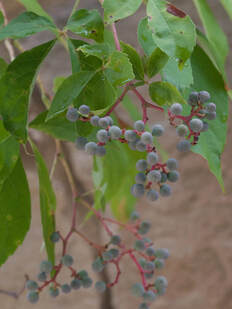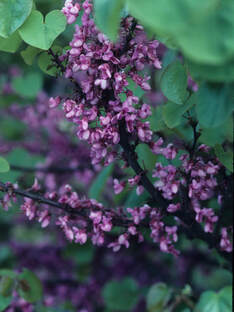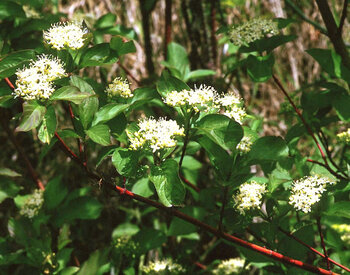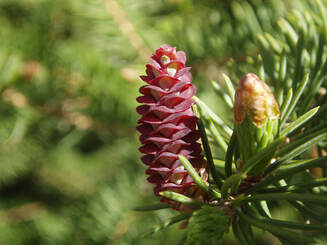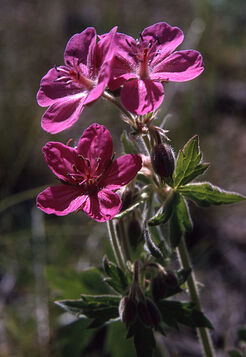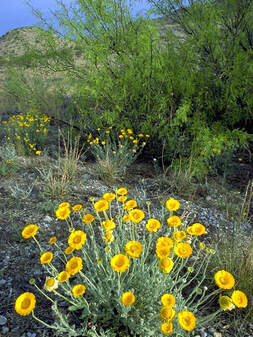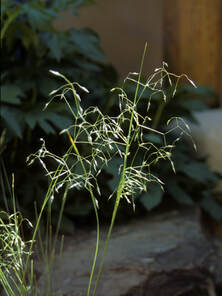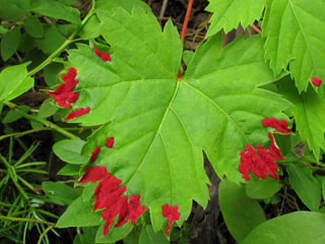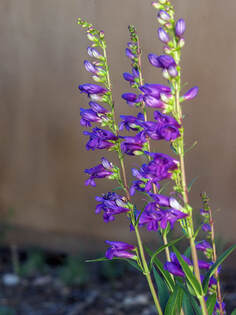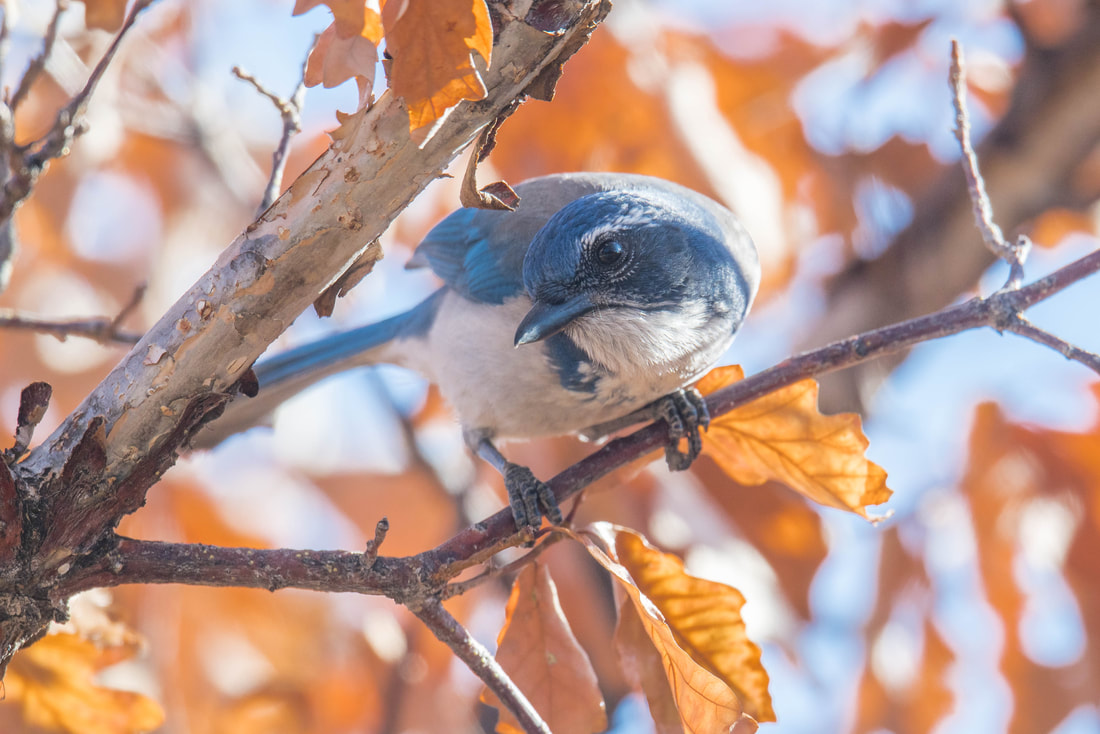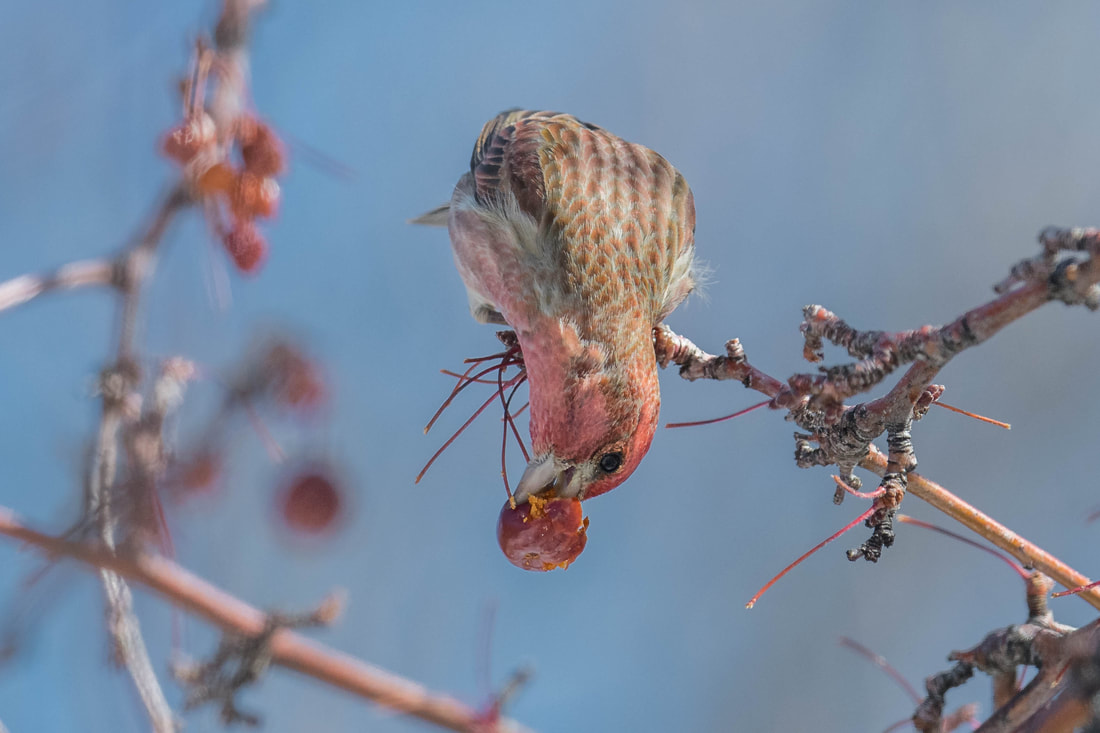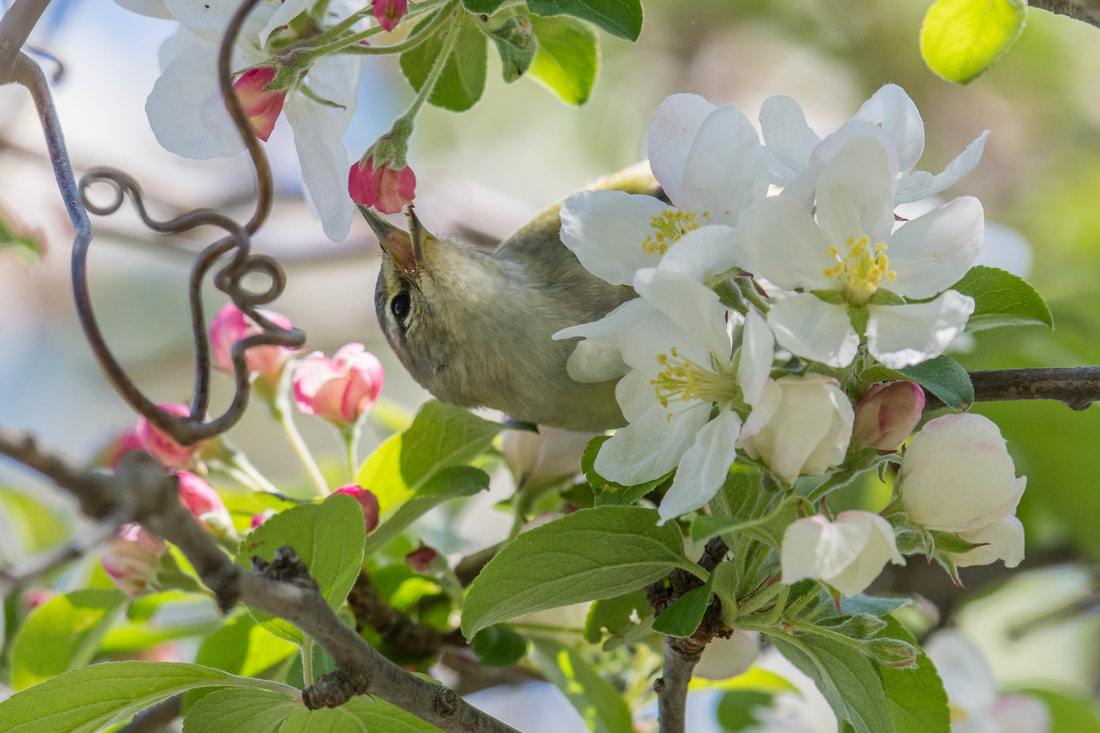|
If you are trying to attract more birds to your backyard, adding native plants to your garden can benefit you, birds, pollinators, and other wildlife. Native plants have adaptations that exotic plants lack, allowing them to grow with less water and fertilizers while also requiring less maintenance. The climate, soil, and water of Northern Nevada make it tricky to grow certain plants in this climate. Selecting plants that are cold hardy and drought tolerant saves time and money. These types of native plants are more likely to make it through our harsh winters and dry summers.
Nectar-rich flowers will attract hummingbirds and other pollinators, such as bees and butterflies. The flowers that are successfully pollinated during the spring and summertime will provide seeds and fruit for birds to eat throughout the fall and winter. Native flowers will also attract beneficial bugs to feed migrant and nesting birds and control the number of harmful pests. Trees are essential to make your yard more appealing to birds. Native trees provide shade, nesting sites, food, and perches for many backyard avian visitors. Most trees, however, take many years to attain a large size. For those looking for a quicker solution, fast-growing native trees like native willows (Salix spp.), cottonwoods, and aspens (Populus spp.) and ornamentals like Dogwood (Cornus spp.) are popular among birds and fast-growing. Native shrubs also provide a place of rest and shade for birds, including those that would not otherwise visit your yard. Some shrubs that do well in our climate include cherries (Prunus spp.), junipers (Juniperus spp.), elderberries (Sambucus spp.), and raspberries (Rubus spp.), providing tasty berries throughout the summer and fall. Native gardens encourage beneficial insect populations, a vital resource for nesting birds and the surrounding ecosystem. If you see a boost in insect populations in your native plant garden, think twice before using pesticides. It can be extremely harmful, or even deadly if birds consume insects treated with pesticides. Consider alternatives or talk to a professional if you are concerned about insect populations in your garden. What is my Hardiness Zone? The rule for gardening in the Reno area is that once the snow is off Peavine, you are safe to plant. Here are 10 plants that LAS recommends to get your bird-friendly native plant garden started: 1. Virginia Creeper
|
|||||||||||||||||||||||||||||||||||||||||||||||||||||||||||||||||||||||||||||||||||||||||||||||||||||||||||||||||||||||||||||||||||||||||||||||||||||||||||||||||||||||||||||||||||||||||||||||||||||||||||||||||||||||||||||||||||||||||||||||||||||||||||||||||||||||||
|
This fast-growing, woody vine produces small clusters of blackish berries in early summer. In the fall, the leaves turn an attractive bright red. This plant has compound leaves with five leaflets that have toothed edges. Not only do birds love this plant, but other animals such as squirrels, chipmunks, and deer will also snack on this plant. Plant this vine along fences or a trellis. Virginia Creepers are great for ground cover as well. If there is nothing for the vine to grow up, it will simply grow outward making it an effective tool for erosion control. This plant can grow in a variety of conditions and is very hardy overall. It grows best in well-drained soil and full sun, but will likely grow anywhere. Water regularly until established, then occasional thorough waterings when necessary. |
2. Western Redbud
(Cercis orbiculata)
|
Also known as California Redbud, this shrub belongs to the Pea family. The flowers last about two weeks, appearing before the leaves, and range in color from magenta pink, to red-violet. The leaves are rounded or heart-shaped and change colors in the fall to yellow then red and brown. The pods turn from purple to brown when ripe and contain 7 bean-like seeds. This is a larger shrub or small tree that grows up to 10-15 ft. tall. The nectar draws in hummingbirds, other nectar-loving birds, and pollinating insects such as bumblebees. The seeds are eaten and then dispersed by birds. This is a fairly easy-going and low-maintenance plant once established. It is cold hearty and drought resistant. Plant in full sun to partial shade with well-draining soil. Perfect for a border or front yard plant. |
3. Red-osier Dogwood
(Cornus Sericea)
|
Red-osier or red-twig dogwood is a medium-sized, deciduous, loose, spreading shrub. Typically growing 6-12 ft. tall, with conspicuous red bark and twigs. In the winter, the red bark can offer a pop of color to a dull landscape. This shrub blooms from June to August with clusters of creamy-white blossoms. The flowers are followed by clusters of small, fleshy white berries. The berries feed a large number of bird species such as many species of game birds, Wood Ducks, Bluebirds, Grosbeaks, Crows, Purple Finches, Northern Flickers, Magpies, Mockingbirds, vireos, and many more. Mammals also forage on the leaves and twigs, such as bears, beavers, rabbits, squirrels, chipmunks, mountain beavers, and deer. |
4. White Spruce
(Picea Glauca)
|
White spruce is a part of the Pine family. The evergreen foliage and seed-bearing cones provide shelter and food for a wide array of wildlife species. This is a faster-growing pine; once mature, these trees can reach heights of 40-60 feet tall, growing as wide as 10-20 feet. The mature, light-brown cones are quite small (only 1-2 in.) with thin scales, allowing many different species of birds to access the seeds inside. If you plant this tree in your yard, expect visitors such as Crossbills, Evening Grosbeaks, and Red-breasted Nuthatches to feast on the cones. Many other birds will seek shelter and potentially nest among the foliage. The evergreen foliage is eaten by a variety of wildlife species such as grouse, rabbits, and deer. |
5. Sticky Purple Geranium
(Geranium viscosissimum)
|
Sticky Purple Geranium, also known as Wild Geranium, is a native perennial forb with flowers that are pinkish-lavender to deep purple-magenta. Seeds occur in capsules that are elongated and hairy. The seeds and leaves of this plant are popular among birds, small mammals, deer, and others. This plant also attracts native pollinators such as butterflies, bees, and flies. This is a unique wildflower, it is protocarnivorous. This means that it can dissolve protein from insects trapped on its sticky leaf surface. It is an adaptation to grow in nutrient-poor conditions. This forb is drought tolerant, requiring little water once established. Plant in full to partial sun alongside other wildflowers. Like all geraniums, this species can become established in your garden by planting its seeds. Plant seeds in the fall at 1/4 inch below the soil. |
6. Desert Marigold
(Baileya multiradiata)
|
Desert Marigolds are herbaceous, short-lived perennials. They have bright yellow, daisy-like flowers that clump together to form a mound. The showy flowers rise from a leafless stalk and bloom throughout the summer and fall. Their long-lasting blooms can reach one foot in height, turning papery with age. Care for this plant is relatively low. Due to their high seed production, once a plant has successfully produced seeds, new plants can establish from the dropped seeds. Birds will feast on their seeds once they are ripe and help disperse the seeds to other parts of your garden. Sow Desert Marigold seeds 1/4 inch deep in the fall or spring in a sunny area with well-drained soil. This plant thrives in poor, dry soil and might be sensitive to over-watering. Regular watering is not usually necessary but, an occasional drink might help the plant produce blooms quicker. |
7. Blue Grama
(Bouteloua gracilis)
|
This is a short, native, perennial grass with a green to greyish color and seed heads resembling small pennants. This grass is increasing in popularity due to its ability to withstand harsh drought conditions and its seed-producing ability, feeding many seed-eating birds and small mammals. This grass grows well among wildflowers and other native grasses. This grass can grow in almost any type of well-drained soil in full sun. Once established, this plant requires very little water. This is a perfect option to plant in areas that are typically overrun with weeds. After clearing the area from weeds, plant grama and other drought-resistant wildflower seeds in the area to keep weeds at a minimum. |
8. Indian Ricegrass
(Achnatherum hymenoides)
|
This is a perennial bunchgrass with sage-green foliage that appears slightly wiry. In the fall, the seedheads form an elegant inflorescence containing nutritious seeds that are a favorite among small birds, such as sparrows and doves. The foliage also provides cover for birds and other small animals. This is a hardy plant that tolerates drought and extreme seasonal temperatures. This plant thrives in well-drained, textured soils in full sun (southern exposure). Seeds should be planted in the fall at a depth of 1/2-1 inch. . Once the grass is established, lightly water and fertilize to improve growth. The establishment of this species is on the slower side, but once it is established, the high seed production will surely attract lots of hungry birds. |
9. Rocky Mountain Maple
(Acer glabrum)
|
This tree or shrub is known for its ability to provide wildlife habitat, stabilize slopes, and provides gorgeous and low-maintenance landscaping. It has red bark contrasting the deciduous, small, light-green leaves. It can grow up to 25 feet tall but 5-7 feet is the average height. Female plants have inconspicuous, yellow-green flowers forming short branched, droopy clusters. In the fall, the tree produces winged nutlets (samaras). This shrubby tree provides a large amount of food and habitat for a wide diversity of wildlife. Birds often seek these trees out to build their nests in the spring and to feast on the seeds in the fall. |
This is a shade-tolerant plant that is fairly hearty but it does not do well in full sun or windy conditions. It is naturally an understory plant that grows under pine and fir trees. It can grow in a variety of soil conditions and is very easy to care for.
10. Rocky Mountain Penstemon
(Penstemon strictus)
|
Rocky Mountain Penstemon or Beardtongue is an evergreen perennial forb and is a favorite of hummingbirds and small seed-eating birds. The long-lasting, showy flowers bloom in the late spring to early summer. The royal blue to purple flowers form clusters on the stalks arranged on one side of the flower spike.
Rabbits tend to avoid this plant while hummingbirds and other pollinators will stop by to enjoy nectar from its flowers. These are cold-hardy and drought-tolerant plants making them ideal for Northern Nevada Climate. It typically grows 12 to 36 inches tall. It prefers full sun to partial shade and well-drained soil, but it can tolerate a variety of soil conditions. |
TREES INCLUDED IN THIS GUIDE:
|
|
The table below contains a comprehensive list of trees native to Northern Nevada and the surrounding areas. The information from this table was sourced from the National Audubon's Native Plant Finder. If you would like a list of plants more specific to your zip code, use the Native Plant Finder and input your zip code for your own list of plants.
Plants can have multiple common names but their scientific names are standardized. Some people prefer to find plants by their scientific name, while others prefer common. That is why we alternatively listed the plants each of the handouts in alphabetical order by their common name. See the list above to find plants in the guide by their scientific name.
If you would like to see pictures of each of the plant, use the .pdf guide or if you are using the web guide, click on the link at the bottom of the description for each plant.
|
PLANT |
DESCRIPTION |
BIRDS ATTRACTED |
|
Ash-Leaf Maple (Acer negundo) |
This fast-growing and fairly short-lived perennial tree, also known as Box Elder, reaches 80 feet in height. It often has several trunks and can form thickets that grow greenish yellow leaves with a March to April bloom time. This tree grows in full sun, in medium to wet soil, and produces winged seeds that birds and squirrels feed on. It tolerates a variety of soils including dry and clay soil, but is intolerant to shade.
|
Grosbeaks and Buntings, Wrens, Crows & Jays, Woodpeckers, Sparrows, Finches, Chickadees & Titmice, Waxwings, Orioles, Wood Warblers, Vireos, Nuthatches, Thrushes, Mockingbirds & Thrashers. |
|
Big-Leaf Maple (Acer macrophyllum)
|
This deciduous tree usually grows 20 to 75 feet tall with a large, often multi-stemmed trunk, a loose, broad crown, and leaves that are the largest of all the maples. Its glossy, dark green foliage turns an attractive yellow-orange in the fall, and its fruit, sweet-tasting flowers, and sap are favored by surrounding wildlife including deer and squirrels. This tree can grow in full sun to shade, and in cool, dry to moist soils. |
Cardinals & Grosbeaks, Chickadees & Titmice, Crows & Jays, Finches, Mockingbirds & Thrashers, Nuthatches, Orioles, Sparrows, Thrushes, Vireos, Waxwings, Wood Warblers, Woodpeckers, Wrens
|
|
Bitter Cherry (Prunus emarginata)
|
Bitter Cherry is a deciduous, perennial shrub that can grow up to 50 feet tall, often forming thickets. It produces white flowers in the spring, followed by extremely bitter, red fruits that are inedible to humans but a favorite of birds. This plant tolerates full sun to partial shade and has low water requirements. |
Orioles, Vireos, Woodpeckers, Crows & Jays, Nuthatches, Chickadees & Titmice, Waxwings, Mockingbirds & Thrashers, Thrushes, Wrens, Grosbeaks and Buntings, Sparrows, Wood Warblers |
|
Black Hawthorn (Crataegus douglasii)
|
Black Hawthorn is a medium-sized shrub that grows 6 to 30 feet tall with thorns and stout branches. Dense clusters of white flowers appear in May and June followed by shiny, purple to black fruits, attracting butterflies and birds. This plant grows best in moist soils and in full sun to partial shade, the best fruit production occurring in full sun. |
Grosbeaks & Buntings, Chickadees & Titmice, Crows & Jays, Mockingbirds & Thrashers, Nuthatches, Orioles, Sparrows, Thrushes, Vireos, Waxwings, Wood Warblers, Woodpeckers, Wrens
|
|
California Buckeye (Aesculus californica)
|
This tree grows 10 to 40 feet in height, and up to 40 feet in crown diameter with silvery-gray bark and dark green foliage. It produces fragrant, white to pale pink flowers from May to July and loses its leaves in the fall and winter. Drought tolerant, this tree can survive in full to partial sun and in poor, dry soils. Though edible to chipmunks and squirrels, the seeds of this plant are toxic to humans if eaten, while the nectar and pollen are poisonous to bees. |
Cardinals & Grosbeaks, Chickadees & Titmice, Crows & Jays, Mockingbirds & Thrashers, Nuthatches, Orioles, Sparrows, Thrushes, Vireos, Waxwings, Wood Warblers, Woodpeckers, Wrens
|
||
|
Cascade Mountain-Ash (Sorbus scopulina)
|
Also called Green’s or Western Mountain-Ash, this small, shrub-like tree can reach up to 12 feet in height, either branching or as a single trunk. It produces shiny, green leaves and clusters of white flowers followed by orange-red berries that persist throughout fall and winter. Cascade Mountain-Ash prefers moist, rich soils, and can withstand full sun to shade. |
Grosbeaks & Buntings, Chickadees & Titmice, Crows & Jays, Mockingbirds & Thrashers, Nuthatches, Orioles, Sparrows, Thrushes, Vireos, Waxwings, Wood Warblers, Woodpeckers, Wrens
|
||
|
Choke Cherry (Prunus virginiana)
|
This perennial, deciduous shrub or small tree grows 20 to 30 feet tall with reddish-brown twigs. The red cherries become black as they ripen from July through August, and provide an important source of food for browsers, small mammals, and many species of birds. It grows in dry to moist, well-drained loams, in full sun to partial shade, and is tolerant to drought and dry/shallow-rocky soil. Choke Cherry is also a larval host for many species of butterflies and moths. |
Orioles, Vireos, Woodpeckers, Chickadees & Titmice, Waxwings, Mockingbirds & Thrashers, Thrushes, Wrens, Grosbeaks and Buntings, Sparrows, Wood Warblers, Crows & Jays, Nuthatches
|
||
|
Douglas-Fir (Pseudotsuga menziesii)
|
This evergreen is a classic Pacific Northwest fir that grows 15 to 100 feet in height, sometimes even 150 feet depending on the environment. Douglas Fir, or Blue Douglas Fir, can be grown in almost any native soil but will sometimes blow down if planted in shallow soils. It is fast-growing, preferring full sun to partial shade and moist conditions. Anyone who has had a Douglas Fir in their home knows that this tree drops needles constantly. |
Grosbeaks & Buntings, Chickadees & Titmice, Crows & Jays, Finches, Mockingbirds & Thrashers, Nuthatches, Orioles, Sparrows, Thrushes, Vireos, Waxwings, Wood Warblers, Woodpeckers, Wrens
|
|
Red Osier (Dogwood) (Cornus alba)
|
Also called Dogwood, this deciduous shrub grows 8 to 10 feet tall and develops showy, vibrant red stems during the fall and winter. Clusters of small, white flowers appear in the late spring before subsequent bluish-white berries. The plant grows best in full sun to partial shade, in moist, well-drained soils, but can tolerate wet, dry, and poor soils. Its flowers attract pollinators such as butterflies, while the fruit is a great source of food for birds. |
Crows & Jays, Wrens, Woodpeckers, Nuthatches, Wood Warblers, Sparrows, Chickadees & Titmice, Thrushes, Waxwings, Vireos, Mockingbirds & Thrashers, Grosbeaks and Buntings, Orioles
|
|
Rocky Mountain Juniper (Juniperus scopulorum)
|
This is a broad, pyramidal tree with shedding, red-brown bark and scale-like, light blue-green to dark green foliage that lies flat against the branches. Rocky Mountain Juniper grows up to 40 feet tall and 15 feet wide, providing cover, nesting site, and seeds for many bird and mammal species. It grows in full sun to partial shade, and tolerates drought and salt spray, as well as a variety of dry soil types, including rocky, sandy, loamy, and clay soils. |
Wrens, Thrushes, Nuthatches, Sparrows, Grosbeaks and Buntings, Crows & Jays, Wood Warblers, Mockingbirds & Thrashers, Waxwings, Orioles, Finches, Chickadees & Titmice
|
|
Rocky Mountain Maple (Acer glabrum)
|
Rocky Mountain maple is a large, deciduous shrub or small tree that grows 10 to 30 feet tall, but can reach up to 50 feet. Its bark is smooth and gray, its twigs reddish in color, and while its flowers are not noticeable, they are rather aromatic. It is naturally found in moist, open coniferous forests and riparian forests, growing in full sun and well-drained, rocky soils. Deer and livestock browse its shiny foliage. |
Mockingbirds & Thrashers, Thrushes, Orioles, Chickadees & Titmice, Finches, Wood Warblers, Nuthatches, Sparrows, Grosbeaks and Buntings, Crows & Jays, Wrens, Woodpeckers, Vireos, Waxwings |
|
Saskatoon Service-Berry (Amelanchier alnifolia)
|
Also known as Western Serviceberry, Juneberry, or simply Saskatoon, this shrub-like tree is relatively small, producing light green leaves that turn red and orange in the fall. Fragrant, white flowers bloom in the spring, followed by blue berries. Growing 2 to 18 feet tall, this perennial does best in dry to moist, well-drained soils, and can withstand full sun to shade. All native species of Amelanchier are popular with birds that eat fruit. |
Grosbeaks and Buntings, Chickadees & Titmice, Crows & Jays, Finches, Mockingbirds & Thrashers, Nuthatches, Orioles, Sparrows, Thrushes, Vireos, Waxwings, Wood Warblers, Woodpeckers, Wrens
|
|
Scouler's Willow (Salix scouleriana)
|
Scouler’s Willow is a deciduous shrub or small tree that can reach up to 45 feet in height, with dark green leaves that are nearly hairless above and hairy below. Its flowers are tiny and grouped in catkins, which then give way to light reddish-brown, long-pointed seed capsules. This fast-growing plant does well in full sun to shade and in moist to dry soils. |
Grosbeaks and Buntings, Chickadees & Titmice, Crows & Jays, Mockingbirds & Thrashers, Nuthatches, Orioles, Sparrows, Thrushes, Vireos, Waxwings, Wood Warblers, Woodpeckers, Wrens
|
|
Silver Buffalo Berry (Shepherdia argentea)
|
Silver Buffalo-Berry, or simply Buffaloberry, is a deciduous shrub that grows up to 20 feet tall with spiny twigs. Its leaves are green with a covering of fine, silky, silvery hairs, while its flowers are pale yellow with no petals, leading to bright red, fleshy fruit. This perennial plant is low maintenance, tolerating poor soils, drought, and extreme cold, though it grows best in full sun and in dry to moist, rocky, sandy, or clayey soils. |
Vireos, Waxwings, Orioles, Crows & Jays, Woodpeckers, Thrushes, Mockingbirds & Thrashers, Nuthatches, Wood Warblers, Chickadees & Titmice, Wrens, Sparrows, Cardinals & Buntings |
|
Vine Maple (Acer circinatum)
|
Vine Maple, or Oregon Vine Maple, is a multi-stemmed understory shrub or small tree with sprawling branches that reroot, sometimes forming a clump or thicket. Usually reaching about 20 feet in height, Vine Maple bears wine-red flowers in the spring and provides handsome red and orange fall color. The two-winged samara fruits ripen to red in the summer and attract many species of birds and mammals. This perennial, deciduous tree grows in partial shade and moist soils, but will tolerate drier conditions. |
Grosbeaks & Buntings, Chickadees & Titmice, Crows & Jays, Mockingbirds & Thrashers, Nuthatches, Orioles, Sparrows, Thrushes, Vireos, Waxwings, Wood Warblers, Woodpeckers, Wrens
|
|
White Alder (Alnus rhombifolia)
|
White Alder is a deciduous tree with pale green foliage and smooth, whitish to gray bark that grows up to 90 feet tall, usually found close to water. It produces catkins in the fall that, along with its buds, are important food sources for birds and pollinators. This tree grows quickly as well as fixes nitrogen, thriving in partial shade, and in moist to wet soils. |
Grosbeaks & Buntings, Chickadees & Titmice, Crows & Jays, Finches, Mockingbirds & Thrashers, Nuthatches, Orioles, Sparrows, Thrushes, Vireos, Waxwings, Wood Warblers, Woodpeckers, Wrens
|
SHRUBS INCLUDED IN THIS GUIDE:
|
Acer circinatum: Vine Maple
Acer glabrum: Rocky Mountain Maple Aesculus californica: California Buckeye Amelanchier alnifolia: Saskatoon Serviceberry Arctostaphylos uva-ursi: Red Bearberry Artemisia ludoviciana: White Sagebrush Artemisia tridentate: Big Sagebrush Atriplex canescens: Four-Wing Saltbush Castilleja miniata: Paintbrush Cornus alba: Red Osier (Dogwood) Corylus cornuta: Beaked Hazelnut Crataegus douglasii: Black Hawthorne Ephedra nevadensis: Nevada Joint-Fir Epilobium canum: Hummingbird-Trumpet Ericameria nauseosa: Rubber-Rabbitbrush Holodiscus discolor: Creambush Juniperus scopulorum: Rocky Mountain Juniper Lonicera involucrate: Four-Line Honeysuckle Lupinus excubitus: Interior Bush Lupine Prunus andersonii: Desert Peach Prunus emarginata: Bitter Cherry Prunus virginiana: Choke Cherry Rhus aromatic: Fragrant Sumac Ribes aureum: Golden Currant Rosa californica: California Rose Rosa woodsii: Woods' Rose Rubus parviflorus: Western Thimble-Berry Salix scouleriana: Scouler's Willow Salvia dorrii: Gray Ball Sage Sambucus racemose: Red Elder Shepherdia argentea: Silver Buffalo Berry Sorbus scopulina: Cascade Mountain-Ash Symphoricarpos mollis: Creeping Snowberry Vaccinium scoparium: Grouseberry |
The table below contains a list of shrubs native to Northern Nevada and the surrounding areas. The table also has a photo, brief description and a list of the birds attracted to the plant. The information from this table was taken from the National Audubon Native Plant Finder. If you would like a list of plants more specific to your zip code, use the Native Plant Finder and input your zip code for your own list of plants.
Plants can have multiple common names but their scientific names are standardized. Some people prefer to find plants by their scientific name, while others prefer common. That is why we alternatively listed the plants each of the handouts in alphabetical order by their common name. See the list above to find plants in the guide by their scientific name.
|
PLANT |
DESCRIPTION |
BIRDS ATTRACTED |
||
|
Beaked Hazelnut (Corylus cornuta)
|
Beaked Hazelnut, or Beaked Filbert, is a perennial, deciduous shrub that reaches 4 to 8 feet in height and width, often forming thickets. It produces small, yellowish-brown catkins in February and March, which lead to nuts that are a favorite of various bird species and small mammals. Beaked Hazelnut prefers partial shade and moist soils. |
Buntings & Grosbeaks, Chickadees & Titmice, Crows & Jays, Finches, Mockingbirds & Thrashers, Nuthatches, Orioles, Sparrows, Thrushes, Vireos, Waxwings, Wood Warblers, Woodpeckers, Wrens
|
||
|
Big Sagebrush (Artemisia tridentata)
|
Big or Great Basin Sagebrush is an aromatic, many-branched shrub with evergreen, silvery gray foliage. Though it is the dominant shrub across the Great Basin region, this plant is unfortunately endangered by cheatgrass and wildfire in its native range. It can grow up to 10 feet tall in full sun and dry, rocky soils. |
Finches, Chickadees & Titmice, Sparrows, Crows & Jays, Woodpeckers, Grosbeaks and Buntings, Crows & Jays
|
||
|
Bitter Cherry (Prunus emarginata)
|
Bitter Cherry is a deciduous, perennial shrub that can grow up to 50 feet tall, often forming thickets. It produces white flowers in the spring, followed by extremely bitter, red fruits that are inedible to humans but a favorite of birds. This plant tolerates full sun to partial shade and has low water requirements. |
Orioles, Vireos, Woodpeckers, Crows & Jays, Nuthatches, Chickadees & Titmice, Waxwings, Mockingbirds & Thrashers, Thrushes, Wrens, Grosbeaks and Buntings, Sparrows, Wood Warblers |
||
|
Black Hawthorn (Crataegus douglasii)
|
Black Hawthorn is a medium-sized shrub that grows 6 to 30 feet tall with thorns and stout branches. Dense clusters of white flowers appear in May and June followed by shiny, purple to black fruits, attracting butterflies and birds. This plant grows best in moist soils and in full sun to partial shade, the best fruit production occurring in full sun. |
Grosbeaks & Buntings, Chickadees & Titmice, Crows & Jays, Mockingbirds & Thrashers, Nuthatches, Orioles, Sparrows, Thrushes, Vireos, Waxwings, Wood Warblers, Woodpeckers, Wrens
|
||
|
California Buckeye (Aesculus californica)
|
This tree grows 10 to 40 feet in height, and up to 40 feet in crown diameter with silvery-gray bark and dark green foliage. It produces fragrant, white to pale pink flowers from May to July and loses its leaves in the fall and winter. Drought tolerant, this tree can survive in full to partial sun and in poor, dry soils. Though edible to chipmunks and squirrels, the seeds of this plant are toxic to humans if eaten, while the nectar and pollen are poisonous to bees. |
Grosbeaks & Buntings, Chickadees & Titmice, Crows & Jays, Mockingbirds & Thrashers, Nuthatches, Orioles, Sparrows, Thrushes, Vireos, Waxwings, Wood Warblers, Woodpeckers, Wrens |
|
California Rose (Rosa californica)
|
California Rose or California Wildrose is a perennial, deciduous shrub that can form thickets, growing up to 8 to 10 feet in height and width. It produces thorny stems topped with open-faced, pink flowers from May through August. This plant loses its leaves in the winter, and may grow berries, though not always. It can grow in full sun to shade, and though drought tolerant, this shrub grows best in moist soils near water.
|
Buntings & Grosbeaks, Chickadees & Titmice, Crows & Jays, Mockingbirds & Thrashers, Nuthatches, Orioles, Sparrows, Thrushes, Vireos, Waxwings, Wood Warblers, Woodpeckers, Wrens
|
|
Cascade Mountain-Ash (Sorbus scopulina)
|
Also called Green’s or Western Mountain-Ash, this small, shrub-like tree can reach up to 12 feet in height, either branching or as a single trunk. It produces shiny, green leaves and clusters of white flowers followed by orange-red berries that persist throughout fall and winter. Cascade Mountain-Ash prefers moist, rich soils, and can withstand full sun to shade. |
Grosbeaks & Buntings, Chickadees & Titmice, Crows & Jays, Mockingbirds & Thrashers, Nuthatches, Orioles, Sparrows, Thrushes, Vireos, Waxwings, Wood Warblers, Woodpeckers, Wrens
|
|
Choke Cherry (Prunus virginiana)
|
This perennial, deciduous shrub or small tree grows 20 to 30 feet tall with reddish-brown twigs. The red cherries become black as they ripen from July through August, and provide an important source of food for browsers, small mammals, and many species of birds. It grows in dry to moist, well-drained loams, in full sun to partial shade, and is tolerant to drought and dry/shallow-rocky soil. Choke Cherry is also a larval host for many species of butterflies and moths. |
Orioles, Vireos, Woodpeckers, Chickadees & Titmice, Waxwings, Mockingbirds & Thrashers, Thrushes, Wrens, Grosbeaks and Buntings, Sparrows, Wood Warblers, Crows & Jays, Nuthatches
|
||
|
Creambush (Holodiscus discolor)
|
Also known as Ocean Spray, Hillside Ocean-Spray, and Mountain Spray, this fast-growing, deciduous shrub reaches up to 7 feet in height. The pale, lilac-like flower plumes bloom in late spring to early summer, nearly covering the shrub completely. The flowers then turn a tan to brown color and last on the plant through winter. This plant can grow in full sun to partial shade, and prefers dry to moist, rocky or gravelly soils. |
Woodpeckers, Crows & Jays, Finches, Chickadees & Titmice, Grosbeaks and Buntings, Sparrows |
||
|
Creeping Snowberry (Symphoricarpos mollis)
|
This creeping shrub also goes by the names Southern California Snowberry and Trip Vine because of its low, sprawling style of growing, though it only reaches about 1 1/2 feet in height. It produces pink flowers in early summer, followed by clusters of white berries. This plant can tolerate shade to full sun and a variety of dry soils. |
Orioles, Vireos, Woodpeckers, Chickadees & Titmice, Waxwings, Mockingbirds & Thrashers, Thrushes, Wrens, Grosbeaks and Buntings, Sparrows, Wood Warblers, Crows & Jays, Nuthatches |
||
|
Desert Peach (Prunus andersonii)
|
Desert Peach is a perennial, deciduous shrub that can reach up to 7 feet in height and 5 feet in diameter. A member of the rose family, this plant has spiny twigs and produces showy, pink flowers with whisker-like stamens from March to June followed by reddish-orange fruit. It tolerates full sun and requires little water, preferring sandy or well-drained, granite soil. |
Wood Warblers, Mockingbirds & Thrashers, Wrens, Vireos, Crows & Jays, Thrushes, Sparrows, Grosbeaks and Buntings, Chickadees & Titmice, Woodpeckers, Orioles, Nuthatches
|
||
|
Four-Line Honeysuckle (Lonicera involucrata) |
This tall shrub gets its name from its uniquely paired flowers and berries, and also goes by the names Black Twinberry, Twinberry Honeysuckle, and Bearberry Honeysuckle. It is a perennial, deciduous shrub with shiny, opposite leaves and pairs of tubular yellow flowers on red stems. The flowers provide nectar for hummingbirds while its black berries are eaten by various other birds. The shrub can grow in full sun to shade, in moist to wet soils. |
Sparrows, Wood Warblers, Grosbeaks and Buntings, Hummingbirds, Chickadees & Titmice, Wrens, Mockingbirds & Thrashers
|
||
|
Four-Wing Saltbush (Atriplex canescens)
|
Also known as Chamiso and Wing-scale, this many-branched, semi-evergreen shrub typically grows up to 2 to 3 feet tall but can reach up to 8 feet in partial shade and dry, well-drained soils. The young stems and leaves are covered with minute, white scales that helps protect the plant against water loss. The name "Saltbush" refers to the alkaline soil habitats in which the plant grows. |
Mockingbirds & Thrashers, Crows & Jays, Sparrows, Woodpeckers, Orioles, Vireos, Wood Warblers, Chickadees & Titmice, Waxwings, Grosbeaks and Buntings, Finches |
||
|
Fragrant Sumac (Rhus aromatic)
|
Also known as Aromatic Sumac, Lemon Sumac, and Polecat Bush, this aromatic, deciduous, perennial shrub grows 6 to 12 feet tall. It has glossy, blue-green, toothed leaves that turn red, purple, and yellow in the fall. Yellow flowers bloom from April to June before growing into dark-red berries that feed birds and small mammals. It is deer resistant, and grows in full sun to shade, requiring a low amount of water. It grows in a variety of dry to moist soils. |
Grosbeaks & Buntings, Chickadees & Titmice, Crows & Jays, Mockingbirds & Thrashers, Nuthatches, Orioles, Sparrows, Thrushes, Vireos, Waxwings, Wood Warblers, Woodpeckers, Wrens
|
||
|
Golden Currant (Ribes aureum)
|
This is a short, deciduous shrub that grows 3 to 6 feet in height. Its fragrant, yellow flowers bloom from April to May and produce berries that can be yellow, red, or purple when ripe. This plant is adaptable, tolerating drought, and typically growing in full sun to partial shade, in moist to dry soils. The fruit of Golden Currant attracts birds and mammals, while the flowers provide nectar to hummingbirds and pollinating insects. |
Mockingbirds & Thrashers, Crows & Jays, Sparrows, Nuthatches, Woodpeckers, Wrens, Vireos, Wood Warblers, Chickadees & Titmice, Waxwings, Grosbeaks and Buntings, Thrushes, Orioles |
||
|
Gray Ball Sage (Salvia dorrii)
|
This perennial shrub is also known as Purple, Desert, or Dorrii Sage. It grows to 3 feet in height and width and produces silvery foliage and clusters of deep purple flowers in May and June. It requires very little water and does best in well-drained soils and full sun. This plant is especially valuable to pollinators like bees. |
Sparrows, Crows & Jays, Grosbeaks and Buntings, Chickadees & Titmice, Woodpeckers, Finches |
||
|
Grouseberry (Vaccinium scoparium)
|
This small, squat shrub is also known as Grouse Whortleberry or Littleleaf Huckleberry. It is a perennial that reaches 20 inches in height, typically found in coniferous forests. Urn-shaped, pink to red flowers bloom in June and July, followed by bright red berries. Grouseberry is an understory plant, usually growing in the shade and in moist soils. |
Grosbeaks & Buntings, Chickadees & Titmice, Crows & Jays, Mockingbirds & Thrashers, Nuthatches, Orioles, Sparrows, Thrushes, Vireos, Waxwings, Wood Warblers, Woodpeckers, Wrens
|
||
|
Paintbrush (Castilleja miniata)
|
Great Red Indian-Paintbrush or Meadow Paintbrush is an herbaceous perennial that grows 1 1/2 to 3 feet tall, with bright green leaves, and flower clusters that range from pale orange to vibrant scarlet and resemble a ragged paintbrush, thus earning it its name. This plant grows in full sun and wet to moist, well-drained soils. Great Red Indian-Paintbrush is often difficult to transplant because its roots grow until they become connected to the roots of other plants in order to partially obtain nutrients from them. |
Hummingbirds |
||
|
Hummingbird-Trumpet (Epilobium canum) |
Also known as California Fuchsia and Zauschneria, this perennial grows up to 3 feet high and wide. As the name suggests, this is an excellent plant for attracting hummingbirds, producing bright red to red-orange, trumpet-shaped flowers from August to October. It tolerates full sun to partial shade and is drought tolerant. |
Wood Warblers, Orioles, Mockingbirds & Thrashers, Waxwings, Sparrows, Hummingbirds, Vireos |
||
|
Interior Bush Lupine (Lupinus excubitus)
|
This plant is also known as Grape Soda Lupine due to its grape soda-scented purple flowers that grow from May to July. One of the smaller bush lupines, it reaches up to 4 feet in height and diameter, attracting butterflies with its flowers and birds with its seeds. This plant tolerates drought and poor soils, but prefers sandy or loam soils. |
Grosbeaks & Buntings, Chickadees & Titmice, Crows & Jays, Mockingbirds & Thrashers, Nuthatches, Orioles, Sparrows, Thrushes, Vireos, Waxwings, Wood Warblers, Woodpeckers, Wrens
|
||
|
Nevada Joint-Fir (Ephedra nevadensis)
|
Nevada Joint-fir is a perennial, deciduous shrub that grows erectly to 5 feet in height. Small leaves fall off the plant early, leaving a yellowish-gray, leafless, broom-like shrub. The stems grow clusters of small, yellow/light brown flowers that form a cone-like inflorescence. This plant grows in full sun, and in dry, sandy or rocky soils.
|
Nuthatches, Grosbeaks and Buntings, Chickadees & Titmice, Sparrows, Woodpeckers, Crows & Jays, Finches |
||
|
Red Bearberry (Arctostaphylos uva-ursi)
|
Also known as Kinnikinnick and Pinemat Manzanita, it is a mat-forming, evergreen shrub that grows 6 to 12 inches tall and up to 6 feet wide. In the spring, it produces lovely white and pink, bell-shaped flowers that later turn into red berries. True to its name, the fruits of this plant are enjoyed by bears, as well as birds and other wildlife. It can grow in full sun to shade, and in dry to moist rocky or sandy, acid soils. |
Grosbeaks & Buntings, Chickadees & Titmice, Crows & Jays, Mockingbirds & Thrashers, Nuthatches, Orioles, Sparrows, Thrushes, Vireos, Waxwings, Wood Warblers, Woodpeckers, Wrens |
||
|
Red Elder (Sambucus racemosa)
|
Otherwise known as Red Elderberry, this treelike shrub grows 8 to 20 feet tall. It produces fragrant, pale, cone-shaped flowers at the ends of stem branches, followed by bright red or purple fruit clusters. The berries are enjoyed by a variety of wildlife, though they can be poisonous to humans if eaten raw. This shrub prefers moist to wet soil, and can grow in full sun to shade. |
Woodpeckers, Nuthatches, Orioles, Crows & Jays, wrens, Mockingbirds & Thrashers, Hummingbirds, Waxwings, Chickadees & Titmice, Grosbeaks and Buntings, Sparrows, Thrushes
|
||
|
Red Osier (Dogwood) (Cornus sericea)
|
Also called Red-barked, Tatarian, or Siberian Dogwood, this deciduous shrub grows 8 to 10 feet tall and develops showy, vibrant red stems during the fall and winter. Clusters of small, white flowers appear in the late spring before subsequent bluish-white berries. The plant grows best in full sun to partial shade, in moist, well-drained soils, but can tolerate wet, dry, and poor soils. Its flowers attract pollinators such as butterflies, while the fruit is a great source of food for birds. |
Crows & Jays, Wrens, Woodpeckers, Nuthatches, Wood Warblers, Sparrows, Chickadees & Titmice, Thrushes, Waxwings, Vireos, Mockingbirds & Thrashers, Grosbeaks and Buntings, Orioles |
||
|
Rocky Mountain Juniper (Juniperus scopulorum) |
Common names for this tree also include Mountain Red Cedar, Colorado Red Cedar, River Juniper, and Western Juniper. This is a broad, pyramidal tree with shedding, red-brown bark and scale-like, light blue-green to dark green foliage that lies flat against the branches. Rocky Mountain Juniper grows up to 40 feet tall and 15 feet wide, providing cover, nesting site, and seeds for many bird and mammal species. It grows in full sun to partial shade, and tolerates drought and salt spray, as well as a variety of dry soil types, including rocky, sandy, loamy, and clay soils. |
Wrens, Thrushes, Nuthatches, Sparrows, Grosbeaks and Buntings, Crows & Jays, Wood Warblers, Mockingbirds & Thrashers, Waxwings, Orioles, Finches, Chickadees & Titmice
|
||
|
Rocky Mountain Maple (Acer glabrum)
|
Rocky Mountain maple is a large, deciduous shrub or small tree that grows 10 to 30 feet tall, but can reach up to 50 feet. Its bark is smooth and gray, its twigs reddish in color, and while its flowers are not noticeable, they are rather aromatic. It is naturally found in moist, open coniferous forests and riparian forests, growing in full sun and well-drained, rocky soils. Deer and livestock browse its shiny foliage. |
Mockingbirds & Thrashers, Thrushes, Orioles, Chickadees & Titmice, Finches, Wood Warblers, Nuthatches, Sparrows, Grosbeaks and Buntings, Crows & Jays, Wrens, Woodpeckers, Vireos, Waxwings |
||
|
Rubber-Rabbitbrush (Ericameria nauseosa)
|
Otherwise known as Gray Rabbitbrush, this 2 to 4 foot tall perennial erupts in late summer with a passionate display of appealing yellow. The yellow flower heads of this dense shrub are especially valuable to pollinators like bees. This plant typically grows in dry, open, grassy spaces. |
Waxwings, Sparrows, Vireos, Wood Warblers, Mockingbirds & Thrashers, Orioles |
||
|
Saskatoon Service-Berry (Amelanchier alnifolia)
|
Also known as Western Serviceberry, Juneberry, or simply Saskatoon, this shrub-like tree is relatively small, producing light green leaves that turn red and orange in the fall. Fragrant, white flowers bloom in the spring, followed by blue berries. Growing 2 to 18 feet tall, this perennial does best in dry to moist, well-drained soils, and can withstand full sun to shade. All native species of Amelanchier are popular with birds that eat fruit. |
Grosbeaks and Buntings, Chickadees & Titmice, Crows & Jays, Finches, Mockingbirds & Thrashers, Nuthatches, Orioles, Sparrows, Thrushes, Vireos, Waxwings, Wood Warblers, Woodpeckers, Wrens |
||
|
Scouler's Willow (Salix scouleriana)
|
Scouler’s Willow is a deciduous shrub or small tree that can reach up to 45 feet in height, with dark green leaves that are nearly hairless above and hairy below. Its flowers are tiny and grouped in catkins, which then give way to light reddish-brown, long-pointed seed capsules. This fast-growing plant does well in full sun to shade and in moist to dry soils. |
Grosbeaks and Buntings, Chickadees & Titmice, Crows & Jays, Mockingbirds & Thrashers, Nuthatches, Orioles, Sparrows, Thrushes, Vireos, Waxwings, Wood Warblers, Woodpeckers, Wrens |
||
|
Silver Buffalo Berry (Shepherdia argentea)
|
Silver Buffalo-Berry, or simply Buffaloberry, is a deciduous shrub that grows up to 20 feet tall with spiny twigs. Its leaves are green with a covering of fine, silky, silvery hairs, while its flowers are pale yellow with no petals, leading to bright red, fleshy fruit. This perennial plant is low maintenance, tolerating poor soils, drought, and extreme cold, though it grows best in full sun and in dry to moist, rocky, sandy, or clayey soils. |
Vireos, Waxwings, Orioles, Crows & Jays, Woodpeckers, Thrushes, Mockingbirds & Thrashers, Nuthatches, Wood Warblers, Chickadees & Titmice, Wrens, Sparrows, Buntings & Buntings |
||
|
Western Thimble-Berry (Rubus parviflorus)
|
Also known simply as Thimbleberry, this dense shrub grows up to 8 feet tall on narrow stems that have no thorns. It produces soft, fuzzy leaves and small, white flowers that yield red fruit that ripen in mid to late summer. This plant prefers dry to moist, rocky soils, and can grow in full sun to shade. |
Grosbeaks and Buntings, Chickadees & Titmice, Crows & Jays, Mockingbirds & Thrashers, Nuthatches, Orioles, Sparrows, Thrushes, Vireos, Waxwings, Wood Warblers, Woodpeckers, Wrens |
||
|
White Sagebrush (Artemisia ludoviciana)
|
This plant has several common names, including Louisiana Sage, Silver Sage, Mugwort Wormwood, and Gray Sagewort. This perennial shrub grows to 3 feet in size, with attractive silvery foliage and small, yellowish flowers that bloom from July to October. White Sagebrush grows in full sun and has a medium to low water requirement, adapting to a variety of soils. |
Grosbeaks and Buntings, Chickadees & Titmice, Crows & Jays, Finches, Sparrows, Woodpeckers
|
||
|
Woods' Rose (Rosa woodsii)
|
Woods’ Rose, or Western Wild Rose, is a thorny, deciduous shrub that often forms thickets, with individual plants growing 2 to 5 feet in height. It starts growing during the early spring, and produces 2 to 4 inch, pale to vibrant pink flowers from May to July. This species has many varieties and can grow in multiple conditions, including full sun to shade, and in dry to moist, sandy or clay soils. |
Grosbeaks and Buntings, Chickadees & Titmice, Crows & Jays, Mockingbirds & Thrashers, Nuthatches, Orioles, Sparrows, Thrushes, Vireos, Waxwings, Wood Warblers, Woodpeckers, Wrens |
||


